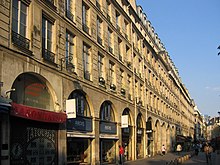
Henry IV, also known by the epithets Good King Henry or Henry the Great, was King of Navarre from 1572 and King of France from 1589 to 1610. He was the first monarch of France from the House of Bourbon, a cadet branch of the Capetian dynasty. He pragmatically balanced the interests of the Catholic and Protestant parties in France as well as among the European states. He was assassinated in 1610 by a Catholic zealot, and was succeeded by his son Louis XIII.

François Ravaillac was a French Catholic who assassinated King Henry IV of France in 1610.
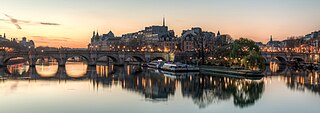
Île de la Cité is an island in the river Seine in the center of Paris. In the 4th century, it was the site of the fortress of the Roman governor. In 508, Clovis I, the first King of the Franks, established his palace on the island. In the 12th century, it became an important religious center, the home of Notre-Dame cathedral, and the royal chapel of Sainte-Chapelle, as well as the city's first hospital, the Hôtel-Dieu. It is also the site of the city's oldest surviving bridge, the Pont Neuf.
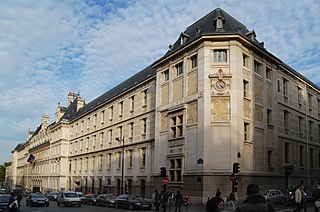
The Lycée Louis-le-Grand, also referred to simply as Louis-le-Grand or by its acronym LLG, is a public Lycée located on rue Saint-Jacques in central Paris.

Châtelet is a station of the Paris Métro and Île-de-France's RER commuter rail service, located in the centre of medieval Paris, on the border between the 1st and 4th arrondissements. It serves RER A, RER B and RER D, as well as Line 1, Line 4, Line 7, Line 11 and Line 14 of the Paris Métro; it is the southern terminus of Line 11. The station is made up of two parts connected by a long corridor: Lines 7 and 11 under the Place du Châtelet and the Quai de Gesvre, next to the Seine; Lines 1, 4 and 14 towards Rue Saint-Denis and the Rue de Rivoli.

The Tuileries Palace was a royal and imperial palace in Paris which stood on the right bank of the Seine, directly in front of the Louvre. It was the Parisian residence of most French monarchs, from Henry IV to Napoleon III, until it was burned by the Paris Commune in 1871.

The Rue du Faubourg Saint-Honoré is a street located in the 8th arrondissement of Paris, France. Relatively narrow and nondescript, especially in comparison to the nearby Avenue des Champs-Élysées, it is cited as being one of the most luxurious and fashionable streets in the world thanks to the presence of virtually every major global fashion house, the Élysée Palace, the Hôtel de Pontalba, the Embassy of Canada, the Embassy of the United Kingdom, as well as numerous art galleries.

The following is a timeline of the history of the city of Paris, France.

Boulevard Saint-Michel is one of the two major streets in the Latin Quarter of Paris, France, the other being Boulevard Saint-Germain. It is a tree-lined boulevard which runs south from the Pont Saint-Michel on the Seine and Place Saint-Michel, crosses Boulevard Saint-Germain and continues alongside the Sorbonne and the Jardin du Luxembourg, ending at the Place Camille Jullian just before the Port-Royal RER station and the Avenue de l'Observatoire. It was created by Baron Haussmann to run parallel to Rue Saint-Jacques which marks the historical north-south axis of Paris. It is known colloquially as Boul'Mich' in French.

Place Bellecour is a large square in the centre of Lyon, France, to the north of the Ainay district. Measuring 312 m by 200 m, it is one of the largest open squares in Europe, and the third biggest square in France, behind the Place des Quinconces in Bordeaux (12.6 ha) and the Place de la Concorde in Paris (8.6 ha). It is also the largest pedestrian square in Europe: vehicles are allowed on the Place de la Concorde and Place des Quinconces.

Vernon is a commune in the French department of Eure, administrative region of Normandy, northern France.
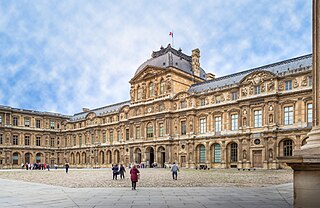
The Louvre Palace, often referred to simply as the Louvre, is an iconic French palace located on the Right Bank of the Seine in Paris, occupying a vast expanse of land between the Tuileries Gardens and the church of Saint-Germain l'Auxerrois. Originally a defensive castle, it has served numerous government-related functions in the past, including intermittently as a royal residence between the 14th and 18th centuries. It is now mostly used by the Louvre Museum, which first opened there in 1793.

The rue Saint-Honoré is a street in the 1st arrondissement of Paris, France.

Nicolas IV de Neufville, seigneur de Villeroy was a secretary of state under four kings of France: Charles IX, Henry III, Henry IV, and Louis XIII. The most distinguished of all sixteenth-century French secretaries, Villeroy rose to prominence during the French Wars of Religion, a period of almost insoluble difficulties for the French monarchy and government. Despite faithfully serving Henry III, Villeroy found himself sacked by him without explanation in 1588, along with all the king's ministers. He was reinstated by Henry IV in 1594 and became more important than ever before. He remained in office until his death in 1617 during the reign of Louis XIII.
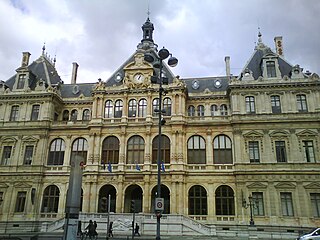
Les Cordeliers is one of the central quarters in the 2nd arrondissement of Lyon, France. It is mainly known for the Place des Cordeliers in its centre. Around the square, there are many notable monuments, including the Église Saint-Bonaventure and the Palais de la Bourse.

The Rue Burdeau is a street located in the 1st arrondissement of Lyon, at the bottom of the slopes of La Croix-Rousse, just above the Église Saint-Polycarpe, between the Saône and the Rhône. It leads at one side to the Montée Saint-Sébastien and at the other to the Jardin des Plantes and crosses the montée de la Grande Côte which renovation is completed. The street belongs to the zone classified as World Heritage Site by UNESCO.

Rue Bonaparte is a street in the 6th arrondissement of Paris. It spans the Quai Voltaire/Quai Malaquais to the Jardin du Luxembourg, crossing the Place Saint-Germain-des-Prés and the place Saint-Sulpice and has housed many of France's most famous names and institutions as well as other well-known figures from abroad. The street runs through the heart of the fashionable Left Bank and is characterised by a number of 'hôtels particuliers' and elegant apartment buildings as well as being bounded by the river at one end and the park at the other. With fifteen buildings or monuments classified as Monument Historique, it has more such listed sites than any other street in the 6th arrondissement.
The Rue Rambuteau is a street in Paris, France, named after the Count de Rambuteau who started the widening of the road prior to Haussmann's renovation of Paris. The philosopher Henri Lefebvre lived on the street and observed from his window the rhythms of everyday life at the intersection located behind the Centre Georges Pompidou.
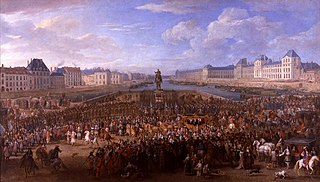
Paris in the 17th century was the largest city in Europe, with a population of half a million, matched in size only by London. It was ruled in turn by three monarchs; Henry IV, Louis XIII, and Louis XIV, and saw the building of some of the city's most famous parks and monuments, including the Pont Neuf, the Palais Royal, the newly joined Louvre and Tuileries Palace, the Place des Vosges, and the Luxembourg Garden. It was also a flourishing center of French science and the arts; it saw the founding of the Paris Observatory, the French Academy of Sciences and the first botanical garden in Paris, which also became the first park in Paris open to the public. The first permanent theater opened, the Comédie-Française was founded, and the first French opera and French ballets had their premieres. Paris became the home of the new Royal Academy of Painting and Sculpture, and of some of France's most famous writers, including Pierre Corneille, Jean Racine, La Fontaine and Moliere. Urban innovations for the city included the first street lighting, the first public transport, the first building code, and the first new aqueduct since Roman times.
Claude Vellefaux was a 16th/17th-century French architect, who had the Hôpital Saint-Louis built in 1611 at the request of Henry IV of France.
